 The sign at the intersection of Adams Street and Michigan Avenue in downtown Chicago that reads “Illinois US 66: Historic Route Begins” is small, unremarkable, and arguably an unworthy trumpeting of the road that is ahead. Indeed, not a single office drone pays it any mind on this gloomy fall morning as they rush from the city’s lumbering El trains to their designated steel and glass towers for the day. Nevertheless, Ryan and I stand in front of it with beaming smiles and angle our iPhones just right so that we can snap a selfie that will surely be the envy of all.
This is day one of an eight-day, turn-by-turn journey that will cover all 2,448 iconic miles of Route 66, the most famous highway in the United States. It was designated in 1926 and made famous by westward thrill seekers, Dust Bowl migrants, and the oft-covered song of the same name. During its six-decade span it was realigned several times, decommissioned in 1985 in favor of the Interstate Highway System, and brought back to life more recently by road trip enthusiasts, municipalities looking to bolster tourism, and folks wistful of a vanishing America.
Although the road is book ended by Chicago and Los Angeles and winds through the heart of several cities including St. Louis, Oklahoma City, and Albuquerque, the highway is really a journey through numerous small towns to countless to name, some of which have survived and even thrived, off Route 66 nostalgia, and others which have all but rotted. To cross the country via interstate highway is to merely skim the continent, but to do it via painstakingly slow Route 66 is to discover an America that is undeniably friendly, often kitschy, and ultimately vanishing rapidly.
The sign at the intersection of Adams Street and Michigan Avenue in downtown Chicago that reads “Illinois US 66: Historic Route Begins” is small, unremarkable, and arguably an unworthy trumpeting of the road that is ahead. Indeed, not a single office drone pays it any mind on this gloomy fall morning as they rush from the city’s lumbering El trains to their designated steel and glass towers for the day. Nevertheless, Ryan and I stand in front of it with beaming smiles and angle our iPhones just right so that we can snap a selfie that will surely be the envy of all.
This is day one of an eight-day, turn-by-turn journey that will cover all 2,448 iconic miles of Route 66, the most famous highway in the United States. It was designated in 1926 and made famous by westward thrill seekers, Dust Bowl migrants, and the oft-covered song of the same name. During its six-decade span it was realigned several times, decommissioned in 1985 in favor of the Interstate Highway System, and brought back to life more recently by road trip enthusiasts, municipalities looking to bolster tourism, and folks wistful of a vanishing America.
Although the road is book ended by Chicago and Los Angeles and winds through the heart of several cities including St. Louis, Oklahoma City, and Albuquerque, the highway is really a journey through numerous small towns to countless to name, some of which have survived and even thrived, off Route 66 nostalgia, and others which have all but rotted. To cross the country via interstate highway is to merely skim the continent, but to do it via painstakingly slow Route 66 is to discover an America that is undeniably friendly, often kitschy, and ultimately vanishing rapidly.
By Jason Heidemann – Full Story at Passport
]]>
